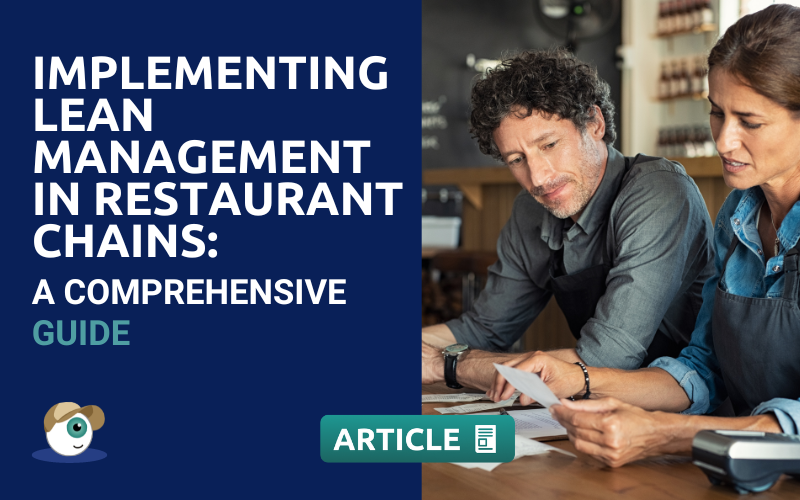Implementing Lean Management in restaurant chains: A comprehensive guide

The restaurant industry thrives on a delicate balance.
Satisfying customer expectations hinges on delivering exceptional dining experiences while maintaining efficient operations and profitability.
However, amidst ever-changing consumer demands, rising costs, and a highly competitive landscape, achieving this balance can be a constant challenge.
This is where Lean Management in restaurant chains emerges as a powerful solution.
Lean Management, a proven methodology rooted in eliminating waste and streamlining processes, offers a strategic approach to optimise restaurant operations.
By embracing Lean principles, restaurant chains can significantly improve efficiency, reduce costs, and ultimately, enhance customer satisfaction.
This comprehensive guide will delve into the core tenets of Lean Management, explore its practical applications in restaurant settings, and showcase how it can pave the way for sustainable success.
Origins and Principles: The Foundations of Lean Management
Lean Management, also known as the Toyota Production System, traces its roots to the manufacturing industry in post-war Japan.
Pioneered by Toyota Motor Corporation, Lean principles aimed to address the challenges of limited resources and disrupted supply chains.
The philosophy emphasises identifying and eliminating waste (non-value-adding activities) while focusing on continuous improvement.
This approach has since been adopted across various industries, including the restaurant sector, where it has proven to be remarkably effective.
Lean Management in Restaurant Chains: Identifying Waste
The cornerstone of Lean Management lies in identifying and eliminating waste, often referred to as “Muda” in Japanese.
In the context of restaurants, waste can manifest in various forms, such as:
- Overproduction: Preparing food in excess of demand, leading to spoilage and inventory costs.
- Waiting: Excessive wait times for customers, either due to inefficient order processing or kitchen delays.
- Transportation: Unnecessary movement of ingredients, equipment, or staff, resulting in wasted time and effort.
- Overprocessing: Complicated or unnecessary steps in food preparation or service, adding no value to the customer experience.
- Inventory: Excessive stock of ingredients or supplies, tying up capital and increasing storage costs.
- Motion: Inefficient movement of staff or equipment within the restaurant, leading to fatigue and reduced productivity.
- Defects: Mistakes in orders, food preparation, or service, resulting in customer dissatisfaction and potential rework costs.
By systematically identifying and eliminating these forms of waste, restaurants can streamline operations, reduce costs, and enhance overall efficiency.
Continuous Improvement (Kaizen): Embracing a Culture of Growth
At the heart of Lean Management lies the powerful concept of Kaizen, a Japanese word translating to “continuous improvement.”
It’s not just a one-time effort, but rather a permanent mindset that permeates every facet of the restaurant.
This philosophy encourages a culture of continuous learning and exploration, where everyone, from chefs to servers to managers, is actively seeking ways to improve their daily tasks.
Here’s how Kaizen fosters a thriving restaurant environment:
- Small, Incremental Changes: Kaizen emphasizes the power of small, gradual improvements. Rather than sweeping, complex changes, the focus is on identifying and fixing minor inefficiencies in daily tasks. This makes improvement manageable and less disruptive to operations.
- Employee Empowerment: Kaizen empowers employees to take ownership of their roles and actively participate in improvement initiatives. They are encouraged to identify bottlenecks, suggest solutions, and implement small changes within their areas of expertise. This fosters a sense of ownership and accountability, leading to a more engaged and motivated workforce.
- Collaboration and Problem-Solving: Kaizen creates a collaborative environment where employees across departments work together to identify and address operational challenges. Open communication is encouraged, allowing for the exchange of ideas and the development of effective solutions.
- Continuous Learning: Kaizen fosters a culture of continuous learning within the restaurant. Employees are encouraged to learn new skills, explore new technologies, and stay up-to-date on industry trends. This continuous learning cycle ensures the restaurant adapts and thrives in a dynamic environment.
Putting Kaizen into Practice:
- Regular team meetings: scheduled regular team meetings are use to discuss challenges, brainstorm solutions, and track progress on improvement initiatives.
- Suggestion boxes: Suggestion boxes or online platforms are implemented where employees can anonymously submit ideas for improvement.
- Recognition and Rewards: Recognise and reward employees who actively participate in Kaizen activities and contribute to streamlining operations.
By embracing Kaizen concept, restaurant chains can cultivate a culture of continuous improvement that leads to a more efficient, adaptable, and ultimately, successful business.

The Seven Wastes (Muda) in Restaurants: Strategies for Elimination
As we’ve seen, Lean Management identifies seven key areas of waste, or “Muda,” that hinder efficiency and profitability.
In the fast-paced world of restaurants, eliminating these wastes can significantly improve operations and customer satisfaction.
Let’s explore each waste category and practical solutions for restaurants to implement:
1. Overproduction
Preparing food in excess of demand leads to spoilage, wasted labor, and unnecessary inventory costs. Overproduction eats away at profits and contributes to food waste.
Lean Solutions
- Implement demand forecasting tools to predict customer traffic and adjust food preparation accordingly.
- Utilise “just-in-time” inventory management to minimise ingredient storage and negotiate bulk discounts with suppliers based on accurate forecasting.
- Offer smaller portion options or “family-style” platters to cater to different appetites and minimise leftovers.
2. Waiting
Excessive customer wait times due to inefficient order processing or kitchen delays can damage the dining experience, frustrating customers and negatively impacting on their experience.
Lean Solutions
- Employ Kanban boards to visualise order flow in the kitchen, identifying bottlenecks that cause delays.
- Implement a designated expediting role to ensure timely delivery of orders from kitchen to waitstaff.
- Offer mobile waitlist systems to manage customer expectations and improve the waiting experience.
3. Transportation
Unnecessary movement of ingredients, equipment, or staff leads to wasted time and reduced productivity. Inefficient movement wastes valuable employee time and effort.
Lean Solutions
- Optimise kitchen layout to minimise the distance staff needs to travel during food preparation.
- Cross-train staff on multiple stations to ensure flexibility and reduce reliance on specific individuals in specific locations.
- Utilise mobile ordering systems to streamline communication between customers and staff, reducing order errors and unnecessary movement.
4. Overprocessing
Complicated or unnecessary steps in food preparation or service add no value to the customer experience and slow down operations, wasting time and resources.
Lean Solutions
- Simplify menu items by offering core dishes with customizable options, reducing prep variations.
- Standardise recipes and procedures to ensure consistent quality and minimise errors.
- Invest in equipment that automates repetitive tasks, freeing up staff for more value-added activities like customer interaction.
5. Inventory
Excessive stock of ingredients or supplies ties up capital, increases storage costs, and risks spoilage.
Lean Solutions
- Conduct regular inventory audits to identify and eliminate expired or rarely used ingredients.
- Implement first-in, first-out (FIFO) inventory management to ensure fresh ingredients are used first.
- Utilise technology like inventory management software to optimise ordering and stock levels, reducing the risk of overstocking.
6. Motion
Inefficient movement of staff or equipment within the restaurant leads to fatigue and reduces productivity. Fatigued staff can lead to safety hazards and decreased quality of service.
Lean Solutions
- Optimise kitchen layout for a smooth workflow, minimising unnecessary movement.
- Conduct ergonomic assessments to ensure workstations are set up for comfort and efficiency.
- Use mobile communication tools like walkie-talkies or tablets to streamline communication and minimise unnecessary trips across the restaurant floor.
7. Defects
Mistakes in orders, food preparation, or service result in customer dissatisfaction, rework costs, and wasted resources. Errors damage customer experience and require additional time and resources to rectify.
Lean Solutions
- Implement a standardised order confirmation process to minimise errors.
- Invest in staff training on proper recipe execution and service protocols.
- Encourage a culture of open communication where staff feel comfortable reporting mistakes so they can be addressed and prevented in the future.
By actively addressing these seven wastes, restaurant chains can streamline operations, enhance efficiency, and create a more profitable and customer-centric environment.
Remember, Lean Management in restaurant chains is an ongoing process, and continuous improvement is key to achieving long-term success.
Success Stories: Examples of Lean Management in Restaurant Chains
Numerous restaurant chains have successfully implemented Lean Management principles, reaping significant benefits in terms of efficiency, cost savings, and customer satisfaction.
Notable examples include:
• McDonald’s: The fast-food giant has embraced Lean principles to streamline operations, reduce food waste, and improve order accuracy.
• Chipotle: The Mexican grill chain has implemented Lean practices to enhance kitchen efficiency, reduce wait times, and minimize food waste.
• Starbucks: The coffeehouse company has utilised Lean methodologies to optimise inventory management, improve customer service, and reduce costs.
Andy: Supporting Lean Implementation in Restaurant Chains
Maximising efficiency and productivity while minimising waste in restaurant chains translates directly to cost savings and a stronger bottom line.
Here’s where food safety and operational excellence assistant Andy, steps in as your partner for successful Lean implementation.
Real-Time Insights, Real-Time Action:
Gone are the days of relying on siloed data and slow reporting. Andy provides real-time operational data accessible at your fingertips or any supervisor’s device. Its expiry labelling tool empowers data-driven decision-making.
Proactive Problem-Solving:
Real-time data from Andy allows supervisors to identify potential bottlenecks or resource shortages before they significantly impact operations. This proactive approach enables managers to make informed decisions in real-time, ensuring smooth service delivery and efficient resource allocation.
Benchmarking and Performance Tracking:
Andy facilitates the easy comparison of performance metrics across different stores. This allows supervisors to identify high-performing units and learn from their best practices. Additionally, tracking performance over time allows for measuring the effectiveness of implemented Lean initiatives.
Streamlined Task Management and Improvement Tracking:
Andy goes beyond data by facilitating the implementation of Lean practices. Its features include:
- Task management: Assign improvement initiatives to specific teams or individuals, track progress, and ensure timely completion. Set deadlines and receive automated reminders to keep improvement efforts on track.
- Project dashboards: Monitor the success of Lean initiatives across all locations in one centralised dashboard. Analyse trends and identify areas where further improvement is needed.
Enhanced Communication and Collaboration for a Lean Culture:
Building a culture of continuous improvement requires seamless communication and collaboration. Andy fosters this by offering centralized communication platform that breaks down silos and facilitates communication between teams across different restaurants, encouraing knowledge sharing and best practice implementation.
Training and Support at Your Fingertips:
Implementing new practices requires effective training. With Andy you can store training resources on Food Safety, Operations, Lean principles and other tools for employees at all levels.
You can also curate a centralised library of best practices for easy reference by all staff members.
By leveraging Andy’s data-driven insights, streamlined task management, and collaborative features, restaurant chains can achieve significant improvements in:
- Efficiency: Optimise staff schedulling, minimise waste, and streamline processes for a smoother operation.
- Productivity: Empower employees with real-time data and collaboration tools, leading to increased output and a more engaged workforce.
- Cost Savings: Reduce waste, optimise inventory management, and improve staffing efficiency, leading to significant cost reductions.
- Resource Management: Utilise resources efficiently by avoiding overstocking and schedulling staff based on actual demand.
With Andy by your side, Lean Management in Restaurant Chains becomes more than just a philosophy – it becomes a data-driven approach to achieving sustainable success in the food service industry.

